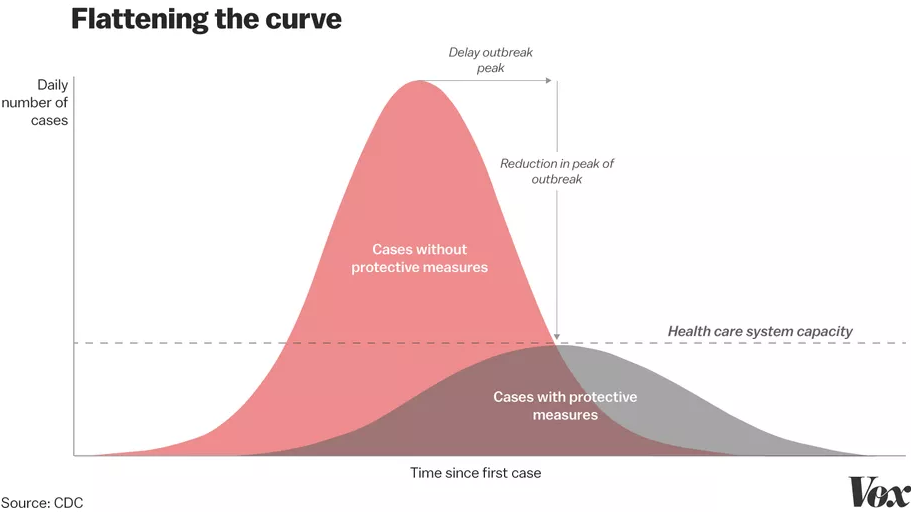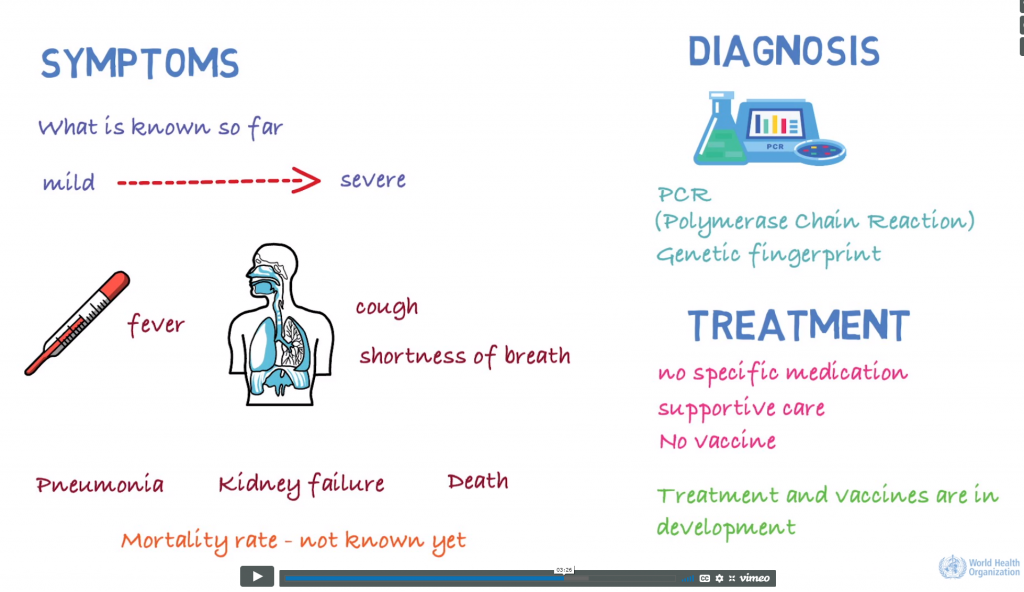Coronavirus has taken over the news, wreaking absolute havoc on every industry and our lives. I wanted to address it to discuss what’s been happening, much of it truly historic, along with the best information I’ve found to date and some actionable steps.
An event of historic proportions
March 12, 2020: Worst stock day since 1987.
Sports and leisure: The NBA, NHL, MLB, MLS, NCAA, XFL, ATP/WTA, and PGA all suspended or canceled their seasons. Some local sporting events and late night shows are playing on without audiences present. Disneyland, California Adventure, and Disney World are closing for at least two weeks. (Previously, only hurricanes and national disasters like JFK’s assassination and 9/11 have closed WDW, and never more than a few days.) Disney Hong Kong and Shanghai were already closed, Tokyo will close 3/15.
Travel/Transport: The entire country of Italy is on mandatory lockdown. (Inspiring footage came out today of people singing together from their balconies.) Incoming travel from Europe is restricted for 30 days or more barring most foreigners (incoming Americans will be funneled through one of thirteen airports). All major cruise lines are completely shut down for at least 30 days. Airline bookings are down as much as 70%, planes are being parked. Hotels are issuing free cancellations and waivers, some have even been commandeered by the state.
Public services: Twelve states as of today have closed all schools (Ohio, Maryland, Oregon, New Mexico, Michigan, West Virginia, Virginia, Louisiana, Illinois, Wisconsin, Washington and Alabama), major metro areas have closed in other states. Hundreds of libraries have closed nationwide. Churches, town halls, and prisons are likewise shutting down normal operations and barring visitors.
A national emergency was declared Friday March 13, in addition to the Fed injecting $1.5 trillion in essentially short-term loans to the market.
Obviously this list goes on and on, growing daily, and fatigue is starting to set in already for myself and I’m sure many of you. It’s difficult to face so much bad news, especially when there’s a lot of fear around what’s next and when this will end.
So let’s talk about what’s true, what’s not, what might be coming, and what we can do about it.
Expert’s View
I’m going to extract a bunch of information from the Joe Rogan podcast with Dr. Michael Osterholm. If you have the time, I encourage you to watch the first ten minutes.
Michael Osterholm is an epidemiologist/infectious disease expert with some serious credentials, feel free to read his bio at the link above. I’ll be giving my CliffsNotes version below.
How is COVID-19 infection spread? The primary mechanism for transmission is just through breathing, it’s a respiratory infection spread through the air.
Do masks help prevent catching the virus? Largely, no. They’re made to protect others from coughing/droplets coming out of your mouth, not germs coming in. N95 masks can be effective, but healthcare workers need these to provide care, and there’s a large shortage right now as these are produced in China.
Does hand washing, hand sanitizer and not touching my face help? Yes, when droplets are on surfaces you touch, but again, the primary way of getting the virus is by breathing it in. Don’t think clean hands or gloves completely protect you in public.
Isn’t this just an old person’s disease? No. Age is the primary risk factor, smoking is another. Obesity is also a risk factor on par with smoking, and 40+% of the U.S. population over the age of 45 is obese. The bright side of this disease is that children aren’t getting sick with COVID-19 like they do with influenza. In China, only 2.1% of the cases were those under the age of 19.
What’s the incubation period (time from exposure until getting sick)? About four days. You can be contagious with no symptoms.
Will it go away in summer when the weather heats up? No. MERS spreads in the Middle East in temperatures above 110 degrees. Saunas will not kill it either.
Was this a man-made biological weapon? No. Dr. Osterholm has a vast amount of experience in this area. There is no evidence at all that this is a bio weapon, genetic virus testing is advanced enough to identify this as clearly jumping from animals to humans in the third week of November.
Why were the cruise ships getting hit so hard? Cruise ships are notorious for recirculating air, particularly in the inside cabins, which don’t have windows or balconies. The infected people should have been evacuated off the ships immediately and put into quarantine.
How long will this last? This is a longer term “corona winter”, not a “corona blizzard” we have to get through in a few days. It will keep unfolding for three to six months. A vaccine is likely to be more than a year away.
How will this stop or slow down without a vaccine in place? Slowing it down is possible through social distancing and limiting contact (more on that below). Eventually, enough people will have been infected and survived with antibodies that they cease spreading the disease – but this would only occur after much loss of life, so that’s a high price to pay.
Comparison to similar diseases? SARS was also a coronavirus, originating from palm civets. When it emerged in 2003, it became clear it wasn’t contagious until around day 5, which is quite different from what’s being seen with COVID-19. Patients with SARS could therefore be isolated before they could infect others. MERS was also a coronavirus, originating from camels in 2012. MERS did not spread easily without close contact, like physical touch, also quite different from COVID-19. Neither SARS nor MERS have a vaccine today. However, when deaths slowed, vaccine funding and research also tapered off.
Additional information from the CDC and WHO
Marc Lipsitch, an epidemiologist at Harvard, believes it’s plausible that 20-60% of adults will eventually be infected with COVID-19. Other experts like Dr. Osterholm also believe the infection rate will be very high, with the percentage of serious cases and fatalities unknown, but likely to be much higher than seasonal flu. The key, then, is to spread those cases out, so hospitals with limited staff and equipment don’t become overwhelmed (as is happening now in Italy). This is the rationale behind the “flattening the curve” image below.

In other words, even if prevention is impossible, and even if the total number of cases remain the same no matter what we do, slowing the spread will save many lives by reducing the load on the healthcare system, both for those infected with COVID-19 and for those with other illnesses that need access to those same healthcare resources of beds, equipment, doctors and nurses.
The World Health Organization has a five minute instructional video posted with some basic graphics. One of the most helpful descriptions is when it comes to symptoms: if you have a fever, cough, *and* difficulty breathing, get screened early, as these are the warning symptoms.

What can I do?
The primary CDC recommendation is simple, avoid being exposed. That’s of course very difficult, as stopping this is like trying to “stop the wind”, it spreads very effectively. The main aim right now is to slow it down.
- Avoid large social gatherings, particularly if you’re part of the risk group (age 55+ or pre-existing medical conditions)
- For now, avoid cruise travel (most are shut down currently anyway) and non-essential air travel
- Limit close contact with others
- Keep your distance in public
- Work from home when possible
- Stay home when sick
- Get plenty of rest
- Exercise – be as healthy as you can be
Working from home: Tips
I have many friends making the transition to work from home now, and it’s been a painful one for many of them. Take a few simple steps to make it as easy as you can. There’s a good chance your employer might cover some costs, but even if they don’t, it’s worth it.
- Videoconferencing: applications like Google Hangouts, Zoom, Skype, etc. are really easy for virtual meetings. If you have a broadband connection or use Netflix streaming, they’ll probably work. (Google Hangouts recommends about 4 Mbps up and down for meetings with 10 people, most broadband connections are higher than that minimum.) If they don’t, run a Speedtest and check into options with your service provider.
- Buy a decent monitor, they’re very cheap now, under $100 for 22-24″
- Likewise set up a desk and chair, working at the couch 8 hours a day is not comfortable for most folks
- Buy some coffee/tea and snacks if you’re missing those
- Schedule a “social” meeting with colleagues, either a lunch session where you chat while eating, or a coffee break. It’ll do wonders for your sanity to keep those social interactions going.
Policy Changes: Difficult problems
Other large-scale measures are outside of the general public’s hands. Many of Dr. Esterholm’s criticisms in his book are around just-in-time deliveries of supplies, offshore sources of supply without backups, and lack of local inventory in the hospitals. 85% of all the world’s IV bags were made in Puerto Rico, and when Hurricane Maria came through, those supplies were devastated (as he predicted). Acute critical drugs people use every day to stay alive, 153 of them, are all generic, and are all made offshore (most of them are produced in China and India). When we have supply chain disruptions like those associated with a world pandemic and can’t produce our own or source them from a different region, it becomes a huge problem for everyone, not just those infected with COVID-19. However, changing those incumbent systems is expensive and politically charged.
School closure is another tricky topic. Dr. Osterholm points out that 38% of the nurses in the country have school-age children. If you close schools for 2-3 months, who takes care of those kids? Nurses staying home will be a huge hit to the healthcare system. Moreover, you have economic impacts from people no longer getting paychecks, and kids losing out on the school lunch programs. It’s a massive issue that’s starting to get press now as schools continue to close. If they’re to remain closed for two or three months, there needs to be a solid long-term plan in place to support the majority of the working class population that can’t stay home with their children.
Summary: The COVID-19 pandemic is serious and warrants behavior change, but don’t panic
When all the coronavirus news started breaking a month ago, I didn’t understand what the big deal was. Isn’t this just like the flu? I was also getting really annoyed at a lot of the misinformation on the news, some of which was ridiculous and thankfully has been toned down.
What I’ve read and heard of the available data has changed my mind. This should be taken seriously, not with panic buys of toilet paper (really?), but with the long-term view that the next few months are going to require changes in the way we work and play. It won’t be easy. But all the signs indicate that being thoughtfully careful at this time will give us the best transition through to the other side of this.